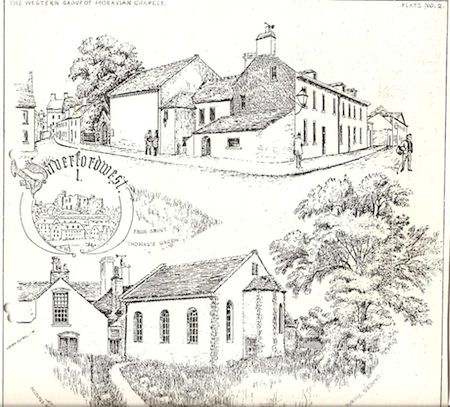Moravian Court

Moravian Court and Gardens
The Moravians were founded by Jan Hus (1369-1415), a Czech priest in the province of Moravia in Czechoslovakia, who predated Martin Luther by over a century and who, with John Wycliffe (1331-1384) is considered the earliest of Protestant Reformers. He was burnt at the stake as a threat to Papal authority.
Much of Czechoslovakia adopted the beliefs of Hus and the Moravian Church, (its members originally called Hussites), spread into other countries.
In Wales, John Gambold (1711-1771), son of William Gambold, (lexicographer and rector of Puncheston in north east Pembrokeshire) embraced the Moravian cause. He was a close friend of John Wesley whilst at Oxford University but their religious paths parted and Gambold went on to become the first bishop of the Moravian Church in the UK in 1753.
He travelled extensively and went on to re-organise the Moravian Church on an international agenda, retiring to Haverfordwest in 1768.
A substantial congregation existed in the town by this point whose members, after using buildings on Haverfordwest Quay to hold meetings, converted houses on this site to use as a meeting place by 1764.
After Gambold’s death, a church was built here with the first service being held on 29th August 1773.
The Moravian denomination was embraced by many of the gentry and services were held here until 1956.
The last minister was George Harp who had previously been a minister amongst the Eskimos in Labrador.
The church was demolished in the 1960s and was replaced by the sheltered accommodation that is here now.
On a wall in the courtyard (which sadly isn’t available to view other than by residents) is a large memorial plaque to John Gambold.
The Moravian Church continues all around the world. The motto of the Moravians is; ‘In essentials, unity; in nonessentials, liberty; and in all things, love.’
Before you continue, consider the area behind you, in front of and to the right of the Leisure Centre. This large area, St Thomas’ Green now and for many years a car park, was used as the cattle market, but is remembered by residents for being the site of the main fair in the county.
Held over three days, in early October, this fair, originally a hiring fair, moved to this location from Portfield in 1834 when the Borough Council gave permission for it to be held on this site, ‘in perpetuity’. Actual hiring, mostly for agricultural work, took place not far from where you are standing.
Always an immense event, the hiring element became a thing of the past from the 1930s and the fair concentrated solely on being a fun fair. A smaller fair was held in May, but the October fair covered, not only St Thomas’ Green, but stretched all the way down Hill Street (which you will come to in a moment) and edged its way into other neighbouring areas.
In its heyday, this fair contained every entertainment it is possible to imagine; boxing booths, rollercoaster, ghost train, with stalls offering every service or purchase associated with such an event.
The local authority evicted the fairground at the point that the Leisure Centre was built in 2009 at a cost of eight million pounds. The building demolished to make way for it had become known as, ‘The County Offices’ and had been used as a local government administrative centre since the 1920s but prior to that had been the county’s only hospital since the 1850s.
Continue along Rosemary Lane, once lined with warehouses (always associated with potatoes) and you come into Hill Street.
Base map from openstreetmap.org
From when were the Moravians active in Haverfordwest? Tap to reveal answer.